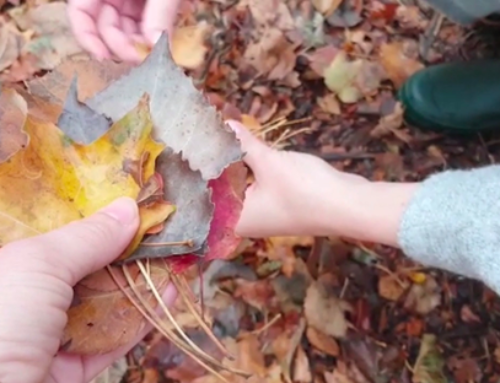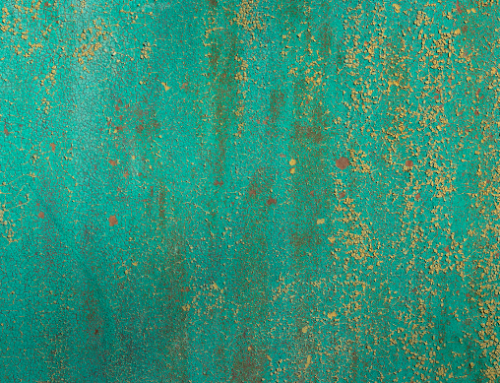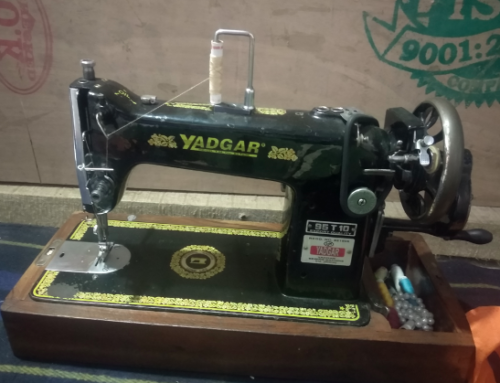For us here, nothing has changed! Elsewhere, governments are talking about new health regulations and vaccines. But here, it’s always risky and difficult to move and travel! We are still struggling to cross the checkpoints to go to work or school […], we still have to protect our land and properties from recurring Israeli settlers’ and soldiers’ attacks. And when someone is sick, they come to me or the other nurse in the community to ask for a shot to relieve pain.
–Hadeel, online conversation with author, April 2020
To learn about the effects of the lockdown declared by the Palestinian Authority (PA) on March 5, 2020 following seven reported cases of COVID-19 in Beit Jala, I asked my students at Bethlehem University to reflect on their experiences. Travel restrictions and curfews are not new to Palestinians; in 2020, however, such restrictions became a widely shared experience among people all over the world. Suddenly all of our lives were reduced to confinement in our houses, behind screens and masks.
We moved to online teaching two weeks after the first closure order. Students well-used to crossing checkpoints and by-pass roads on their way to the university from cities, villages, and refugee camps in al-Quds (Jerusalem), al-Khalil (Hebron) and Bethlehem areas described how recent COVID-19 regulations were affecting them and their families. One of the students explained that the pandemic had not really changed their daily life, but that restrictions on mobility outside her village had increased. Hadeel mentioned that young activists blocked the entrances of al-Rashaida to protect the community from visitors to prevent the spread of the virus.
Although this badly affected members of the community who relied on money earned from international and mostly local tourists, no one protested—not even when the weekly visits by healthcare workers to the one-room clinic in their community had also stopped. Such survival tactics, which mute suffering and accept additional losses in order to avoid losing everything, often seem like the only way to survive conditions of structural violence.
In other countries, too, the impoverished conditions of life brought to light how certain populations experience the normalcy of everyday violence—that is, the systemic violence inherent in inequality, economic exploitation, and local and international systems of political power. However, the ongoing settler colonial structure in Palestine meant that the possibilities of living and mitigating the pandemic were even further reduced.
For Palestinian communities living in areas classified as “C”—the focus of this essay—the confiscation of land and the expulsion of Palestinians by military orders is ongoing and has been happening for more than 100 years (Khalidi 2020). What COVID-19 revealed was the scale of various vulnerabilities experienced by Palestinians, based on their geographic location.
Palestinians’ daily suffering and their struggles to survive dispossession are muted by the Israeli discourse of “illegal” homes and buildings and other exploitative colonial practices. Sometimes, entire areas are declared to be firing zones or closed military training areas, or “protected natural areas,” or new colony sites, meaning that these are seen to be profitable industrial zones for Israeli settlers. This illegality is produced when Palestinian communities in Area C of the West Bank, East Jerusalem, or 48 areas are denied the possibility of obtaining building permits for housing, schools, clinics, or roads. Israeli settlers, however, continue to expand their residential and business structures on confiscated or stolen Palestinian land. I observed first-hand during earlier research (in 2014 and 2018) how the conditions of elimination of Palestinian communities and villages are established.
Kisan is a village in the so-called Area C, south of Bethlehem. When I first visited in April 2018, I remarked upon the blue sky and green land, where kids were playing with small goats. It looked so perfect, like a painting! When I talked with a group of mothers from the community in a small crowded room in the village council, however, I quickly realized that they did not share these feelings. My friend Safad and I had contacted the head of the village council to arrange a focus group meeting with five mothers from the community, hoping to learn about the challenges their children faced to complete their general school education. Instead, we had fourteen mothers show up, and it turned out that school completion and the conditions of caravan classes were the last problems they wanted to discuss.
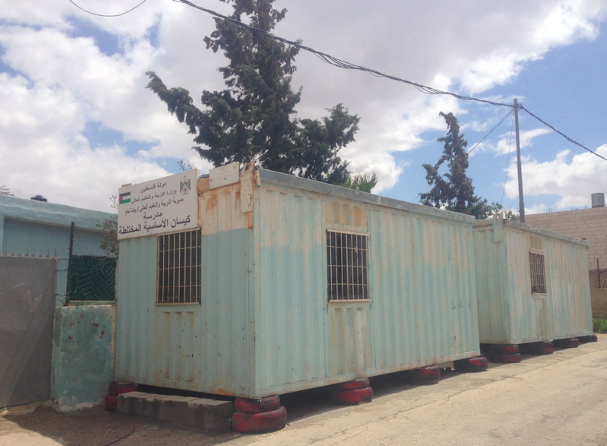
Two classrooms of Kisan co-ed school. Photo credit: Laura Adwan.
They suggested instead that we go outside so they could show us how their green space was shrinking each day. First, they pointed toward the eastern side of the village, asking whether we smelled the unpleasant odour coming from the waste landfill. “We never used to have such big mosquitos or so many insects that spread diseases among our kids. […]One can’t even enjoy a cup of tea anymore, as soon as you pour the tea, bugs and flies fill the cup and your mouth.” Another woman pointed to the western side, where a huge hill of stones was blocking the scene; it appeared to be from a stone crusher for building waste and debris at the Gush Etzion cluster of Israeli settlements. “We and our parents never knew asthma and respiratory diseases like those which our children have to endure.” There was no need to point at the Israeli settlements blocking the north and south sides of the village, whose big signs were much more visible than that of the besieged village.
We discovered that the foul-smelling landfill was one of the few internationally-funded projects that had survived Israeli demolition orders, perhaps because it hosts the garbage coming from the Israeli settlements, as we learned from inhabitants whose relatives work in the landfill. The residents of Kisan are prevented from building or reclaiming their land, beyond the 0.1% of the total designated village area, unless they get permission from the Israeli authorities (ARIJ, 2010). This did not only start after 1995, when 99.9% of the village land was categorized as natural resort and area C, under full Israeli control. The elders of Kisan continue to tell stories about the Israeli army invading and destroying their homes in 1982 for the same reason: because they lacked official building permits. They recall how their village was fiercely attacked yet again in 1988 by Israeli settlers and soldiers, who shot at the sheep and killed a man when he tried to protect his cattle, in addition to destroying all the animal shelters and houses. That same year, the Israelis confiscated a large area of Kisan land to build Ma’aleh Amos settlement on it (al-Fajr English, December 26, 1988, cited in Hazboun 1994, 179). At that time, the villagers decided to live in tents on their lands until they managed to rebuild their houses again.
Forty years later, Kisan residents continue to build without Israeli permits, and most of them have been threatened with demolition orders. While their lands are confiscated for the construction of illegal Israeli settlements, both the army and settlers continue to attack Kisan’s shepherds and farmers. All of this has affected the ability of residents to continue their rain-fed cultivation of wheat, barley and vetch, and many men have been forced to seek work in the Israeli settlements. To add insult to injury, the majority of those who apply for permits to work in Israel had their requests denied, and in turn become unemployed. Many became dependent on the emergency aid program run by the UNRWA, which supported families with basic food items like wheat, cooking oil, chickpeas and lentils. The mothers who joined our focus group were hoping that we could intervene and convince the aid organizations to continue their support, which had been ceased six months earlier. Blocking communities from receiving international aid is another common practice in Area C.
Despite the risks involved, Kisan residents keep and rear sheep and goats, and in spring, they collect and sell wild herbs. Some students leave school for several days during the akoub season, which lasts for two months (Adwan 2018).

A woman prepares akoub. Photo credit: Mati Milstein.
Akoub –a sort of wild thistle– is considered a profitable product that grows in the fields of the village. They collect akoub every spring, despite the increasing frequency of attacks perpetrated by settlers, which have become part of the “normal” daily news on Kisan’s Facebook page. Students are sometimes arrested and taken to Gush Etzion settlement, where they are detained and interrogated for several hours because, according to Israeli law, they entered a “protected natural area” with a “weapon”—the knife used to collect akoub. In the case of one of the students I met in Kisan’s caravan classroom, the parents had to pay a fine of ILS 1200 (USD $350) to have her released from detention, an amount that far exceeded what she could make from collecting and selling akoub.
Medical anthropologist Paul Farmer described the degree to which agency is constrained in the struggles to survive conditions of structural violence. Such agency is correlated inversely, Farmer found, with the ability to resist marginalization and oppression (2004). While COVID-19 extended the space of expected losses, for Palestinians like Hadeel and her community, as well as the residents of Kisan, these experiences of loss were rooted in a long history of dispossession and oppression. The dynamics of social survival have forced many Palestinians to redefine their lives within the limits of the possible—limits in which the ability to act cannot be separated from suffering. The ability to act while living within limits is often “contingent upon yielding conscious control over one’s life” (Jackson 2013). In an effort to keep some degree of control over their lives when external donor assistance was reduced, many Palestinian individuals and organizations resorted to activating local solidarity networks. These included acts of exchange and the provisioning of bread and flour among neighbors in villages during closures and curfews, as well as providing financial donations by zakāt givers (almsgiving in Islam). Other examples included the exchange of medicine and medical equipment, as occurred amongst the families of children with type 1 diabetes.
In addition, several aid initiatives and coalitions were organized to support Gaza, where manufactured shortages of electricity, drinking water, and medical supplies came to define life in “ultimate maximum-security prison” (Pappe 2017). These acts in defiance of the divisions imposed by Israel were extended in April and May 2021 through collective mobilization and protests against the expulsion of Palestinians from their homes in Sheikh Jarrah—expulsions perceived to be part of the ongoing Palestinian Nakba.
Following 19 long months of COVID-19 restrictions ranging from strict curfews to a phony coronavirus state of emergency that was renewed monthly by the PA president, life has gradually been returning to “normal” for Palestinians. This is despite news of a fourth wave, both locally and internationally, and despite the relatively low rate of vaccination among Palestinians.
Very few Palestinians currently wear masks, and fewer observe social distance regulations. This seems to reflect a rising frustration with the already poor health care system and the mounting anger against the PA’s incompetence and corruption, not to mention the violent repression of its critics—as observed in the killing of prominent activist, Nizar Banat—and the targeting of demonstrators by excessive use of force and arbitrary detention.
On the other hand, Israel has used the pandemic restrictions to enforce its old policies of closure and separation of Palestinians (Peteet 2017; Hammami 2019), and to proceed with its colonial expansion. Each time I travel on road No. 60 connecting Jerusalem and al-Khalil, I am shocked by the huge changes on the ground that have taken place since June 2020. Israel did not only confiscate large areas of land to expand its bypass roads and build bridges connecting settlements, but Israeli bulldozers also razed one of the largest Canaanite cemeteries south of Khader. Attacks on Children picking akoub and wild herbs also intensified during the lockdown.
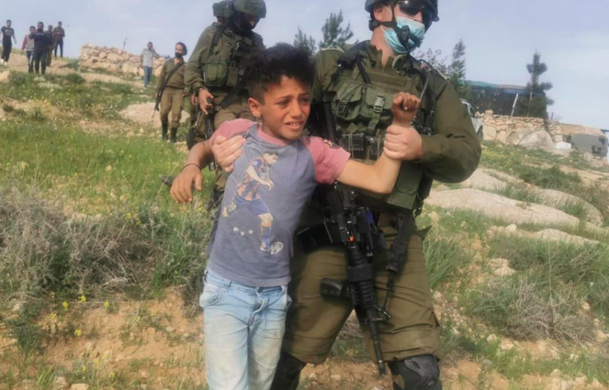
Israeli Army arrests Palestinian kids for picking akoub. Photo credit: B’Tselem/Twitter.
The demolition of houses and the destruction of villages has not stopped either. One recent case was the massive demolition of the village of Humsah, for the sixth time in less than a year. Humsah al-Fouqa is another instance, like Kisan, of the Israeli army’s policy of announcing an area a restricted military zone after launching an ethnic cleansing campaign against its inhabitants.

Palestinians from Humsah al-Fouqa on the rubble of their destroyed village. Photo Credit: WAFA/Suleiman Abu Srur.
In the absence of collective “grassroots organizing” (Tabar 2015) or an institutional presence that might directly confront these continued conditions of dispossession and displacement, Palestinian communities in Kisan, Humsah al-Fouqa, and other fragmented spaces in Gaza, West Bank, and al-Naqab are forced to rely on their own complex strategies of survival in order to live some semblance of a “normal” life.
Acknowledgements
My deep appreciation always goes to my students and the women, men, and children in the communities who shared their stories and time with me and answered my questions. Thanks also to readers who commented on earlier drafts of this essay: Steve Liddle and the AES reviewers Aaron Su and Katie Kilroy-Marac. A warm thanks to Ather Zia for the initiative and to my friend Nayrouz Abu Hatoum from Insaniyyat-Society of Palestinian Anthropologists.
References
Adwan, Laura. 2018. “‘Attendance is Key to our Success’: A qualitative research study exploring education opportunities for female school students in six localities in ‘Area C’ in Bethlehem and al-Khalil governorates.” European Institute of the Mediterranean.
ARIJ (The Applied Research Institute – Jerusalem). Kisan Village Profile. 2010. Bethlehem: ARIJ.
Farmer, Paul. 2004. “An Anthropology of Structural Violence.” Current Anthropology 45 (3): 305-325.
Hammami, Rema. 2019. “Destabilizing Mastery and the Machine: Palestinian Agency and Gendered Embosiment at Israeli Military Checkpoints.” Current Anthropology 60 (19): S87-S97.
Hazboun, Norma. 1994. The Resettlement of the Palestinian Refugees of the Gaza Strip. Ph.D. thesis submitted at the University of Leeds.
Jackson, Michael. 2013. The Wherewithal of Life: Ethics, Migration, and the Question of Well-Being. Berkeley: University of California Press.
Khalidi, Rashid. 2020. The Hundred Years’ War on Palestine: A History of Settler Colonial Conquest and Resistance. New York: Metropolitan Books.
Pappe, Ilan. 2017. The Biggest Prison on Earth: A History of the Occupied Territories. London: Oneworld Publications.
Peteet, Julie. 2017. Space and Mobility in Palestine. Indiana: Indiana University Press.
Tabar, Linda. 2015. “People’s Power: Lessons from the first Intifada.” In Critical Readings of Development under Colonialism: Towards a Political Economy for Liberation in the Occupied Palestinian Territories. Ramallah: Rosa Luxemburg Stiftung and Center for Development Studies, pp. 135-168.
Laura Adwan holds a PhD in Anthropology from the University of Bergen. She is currently an Assistant Professor at Al-Quds Bard College for Arts and Science. Her work focuses on forced displacement and transformations among refugees, rural and Bedouin communities in occupied Palestine and the region, by exploring the ways communities view their lived experiences, situated in a historical political economy.
Cite As: Adwan, Laura. 2023. “Palestinian struggles against ongoing dispossession and fragmentation” In “Pandemic War-Time: Dispatches from Occupied Lands” edited by Ather Zia, American Ethnologist website, September 26 2023, [https://americanethnologist.org/online-content/collections/pandemic-war-time/palestinian-stru…n-by-laura-adwan/]
